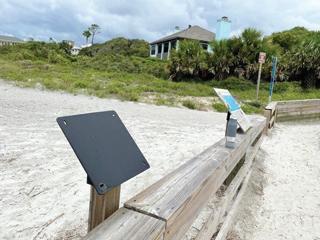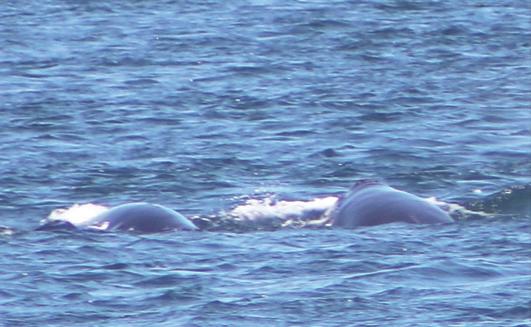
6 minute read
Community Updates
Ken’s Seafood
Shrimp Fish Gator Tail Crawfish Blue Crabs Scallops And More! Support Your Local Seafood Industry! FRESH!
Advertisement
Tue - Thu 12-6 Fri - Sat 10-6 Sun 11-5 9270 Ford Ave. Richmond Hill
(912) 756-8868
Call Ahead For Pick-up!
CIRCA 1870 GOODBREA D HOUSE

BED & BREAKFAST INN
Four andard gue r ms & two suites, all wi large private ba r ms. ay wi us and visit Cumberland Island and hi oric . Marys! Pet friendly. Dietary needs met.
Call for special Southern Tides Rates! (912) 882-7490
www.g dbreadhouse.com info@g dbreadhouse.com 209 Osborne . . Marys, Georgia
Sign Stolen on St. Simons Island
The theft of a St. Simons Island sign explaining the importance of Gould’s Inlet and Georgia barrier islands for shorebirds has spurred calls for tips and hopefully the sign’s return. The sign, installed on the walkway at 15th Street was purchased several years ago with the support of grants and donations from the GADNR Wildlife Viewing Grants Program and Coastal Georgia Audubon. Built to withstand the harsh conditions Photo by Abby Sterling of the beach, it cost nearly $950.00 and there are no funds available to replace it. Manomet biologist Abby Sterling notes that Gould's Inlet is part of the Georgia Barrier Islands Site of Hemispheric Importance for shorebirds, as designated by the Western Hemisphere Shorebird Reserve network.
Donations for the purchase of a new sign can be made at bit.ly/new_birding_sign

Shells added to Glynn Oyster Reefs
Contractors working for GADNR’s Coastal Resources Division (CRD) in June placed approximately 140 tons of loose oyster shell in Jointer Creek, west of Jekyll Island. This brings the total oyster shell put back into Georgia’s estuaries in the last 14 months to 213 tons.
“Oysters, in particular, are very important, as they are ecosystem engineers providing vital services in addition to being a harvest species,” said Cameron Brinton, a marine biologist with CRD. “Oysters help stabilize banks, improve water quality and create essential fish habitat for commercially and recreationally important fish.”
Over the past several months, CRD has focused on three specific projects in Glynn County: a new artificial reef on the Back River near the Torras Causeway containing 68 tons of oyster shell in 7,200 bags; 140 tons of loose shell on the Glynn County public shellfish harvest area on Jointer Creek; and five tons of loose shell in the South Brunswick River near Blythe Island Regional Park.
“The goal of this year’s projects was not only to create new reefs, but also to test new deployment methods,” said Brinton. “In the Back River, we’ve been using bagged oyster shell, which is a method that we’ve successfully used in a number of sites, and at Jointer Creek and Blythe Island, we used loose shell, which requires less manpower and has been very successfully used in other states.”
Although to date the Blythe Island site has only five tons, marine biologists from CRD will return to the site and see how effective the deployment of loose shell was. If the reef is stable, CRD plans to add more shell in the future.
All the oyster deployment sites will be monitored for the next several years looking at several biological and physical metrics to ensure the reefs are stable and self-sustaining.
A healthy reef should have a footprint that does not shrink. In established reefs, this is not usually a problem, Brinton said, but can be a challenge in newly established reefs due to sedimentation caused by Georgia’s eight-foot tidal cycle.
“With over 3,400 miles of tidal creeks and rivers in Georgia, we have a lot of work ahead of us,” Brinton said. “If you want to help us out, support restaurants that partner with us for shell recycling, donate the shell from your own oyster roast, and consider getting a Marine Habitat Conservation license plate for your vehicle or trailer.”
If your organization or business has news to share, please send it to: amy@southerntidesmagazine.com


New England Aquarium scientists have identified a North Atlantic right whale mother and calf spotted swimming off Brier Island, Nova Scotia, as the 18th pair of the season, bringing this season’s total number of documented mothercalf pairs among these critically endangered animals to the highest count since 2013. Lobster and calf swimming off Brier Island, Nova Scotia in May. On May 20, Amy Photo by Amy Tudor Tudor, a naturalist for Mariner Cruises Whale Watching on Brier Island, Nova Scotia, was on the ferry heading toward Long Island, Nova Scotia, when she spotted a whale 100 yards from the ferry. She immediately recognized it as a young right whale, and her husband took photographs from the Brier Island shoreline. Those photographs showed a mother right whale and a small calf moving back and forth in Grand Passage until they swam west out of the passage and into the Bay of Fundy.
On Memorial Day, some of those images were relayed to Dr. Moira Brown of the Canadian Whale Institute who forwarded them to right whale researchers at the Anderson Cabot Center for Ocean Life at the New England Aquarium. Because every mother/calf sighting is important, the team reviewed the pictures quickly and determined this was another new mother for the year.
Aquarium scientists identified the whale as “Lobster,” number 3232 in the North Atlantic Right Whale Catalog maintained at the Aquarium. Lobster, named because the identifying callosity pattern on the front of her head looks like a lobster with claws, was born in 2002 to mother Catspaw (Catalog #1632) and gave birth to her first calf in 2015 at the age of 13. She and her 2015 calf were seen and photographed just briefly by an observer on a dredge in the channel outside of Brunswick, GA, and that was the only sighting of the pair that year.
While right whale mother/calf pairs are usually first detected off the coast of the southeastern U.S. where most calves are born, Lobster joins a dozen or so mothers who were first detected with a calf north of the known calving area. For example, in 2017, two of the five mothers were not seen in the calving grounds; they were first seen with their calves off Cape Cod in April. Whether Lobster and these 2017 mothers gave birth off the southeastern U.S. and were simply not detected, or gave birth in more northern waters, is unknown. At least two mothers are known to have calved in northern waters. One of them, a whale named “Wart” (Catalog #1140), was first sighted with a calf in Cape Cod Bay in January 2013.
Although scientists welcome the news of this new right whale, calving in this decade has been well below the annual average of 23 from the previous decade. While 18 is still relatively low, every calf brings hope because the species remains critically endangered with fewer than 400 whales remaining.

Enjoy Southern Tides Magazine and want it delivered to your home of office? Subscribe now! Visit www.squareup.com/store/southern-tides-magazine $35 for one year/12 issues. Thank you for your support!
BLACKBIRD CHARTER CO.
CAPTAIN RAVEN ABLARD 307•851•6314
Sunset Cruise Fossil Hunting Dolphin Tour Bird Watching Golden Isles Tour Onshore Seining Inshore Fishing Day & Night Water Taxi Kayak Taxi
Please Call or Text for Pricing
All Trips Customizable DOG FRIENDLY
Safe Harbor
Rigging Services, LLC
Proudly Serving Southeast Georgia and Northeast Florida
231-578-5087
info@safeharborriggingservices.com www.safeharborriggingservices.com John S. Ramsey, Owner








